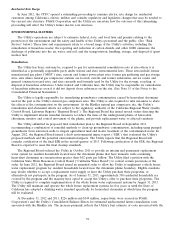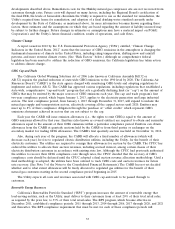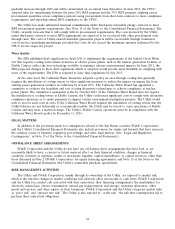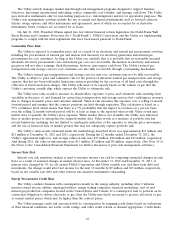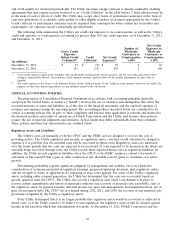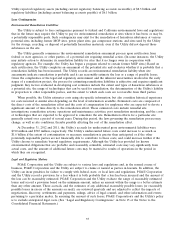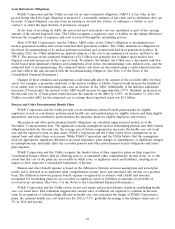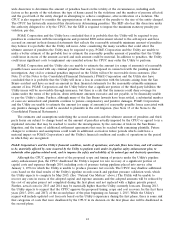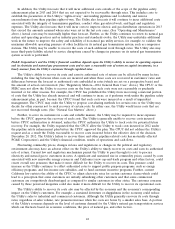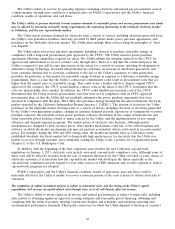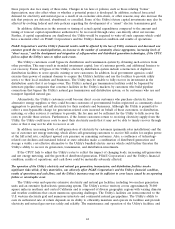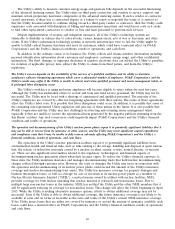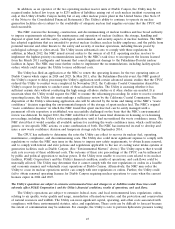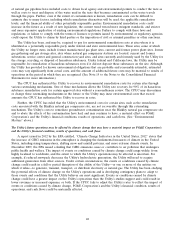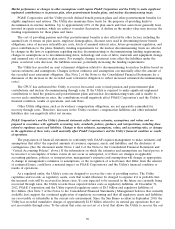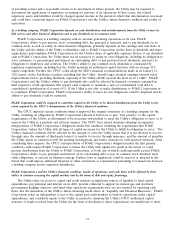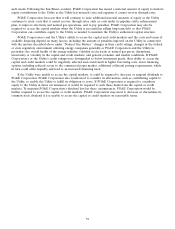PG&E 2012 Annual Report Download - page 46
Download and view the complete annual report
Please find page 46 of the 2012 PG&E annual report below. You can navigate through the pages in the report by either clicking on the pages listed below, or by using the keyword search tool below to find specific information within the annual report.In addition, the Utility forecasts that it will incur additional costs outside of the scope of the pipeline safety
enhancement plan in 2013 and 2014 that are not expected to be recoverable through rates. This includes costs to
establish the parameters of the Utility’s ‘‘rights-of-way’’ surrounding pipelines and to identify and remove
encroachments from these pipeline rights-of-way. The Utility also forecasts it will continue to incur additional costs
associated with the integrity of transmission pipelines, conduct other gas-related work, and legal and regulatory
expenses. The Utility also forecasts that it will incur costs to improve electric and gas distribution operations in 2013
that exceed the amounts assumed when rates were set in the last rate cases. (See ‘‘Operating and Maintenance’’
above.) Actual costs may be materially higher than forecast. Further, as the Utility continues to review its natural gas
system and operating practices and as industry practices and standards evolve, the Utility may undertake additional
work in the future to improve the safety and reliability of its natural gas utility services, for example, to validate the
maximum allowable operating pressure of other facilities in its natural gas transmission system, such as compressor
stations. The Utility may be unable to recover the costs of such additional work through rates. The Utility also may
incur third-party liability related to service disruptions caused by changes in pressure on its natural gas transmission
system as work is performed.
PG&E Corporation’s and the Utility’s financial condition depends upon the Utility’s ability to recover its operating expenses
and its electricity and natural gas procurement costs and to earn a reasonable rate of return on capital investments, in a
timely manner from the Utility’s customers through regulated rates.
The Utility’s ability to recover its costs and earn its authorized rate of return can be affected by many factors,
including the time lag between when costs are incurred and when those costs are recovered in customers’ rates and
differences between the forecast or authorized costs embedded in rates (which are set on a prospective basis) and
the amount of actual costs incurred. (See ‘‘Regulatory Matters—2014 General Rate Case’’ above.) The CPUC or the
FERC may not allow the Utility to recover costs on the basis that such costs were not reasonably or prudently
incurred or for other reasons. For example, the CPUC has prohibited the Utility from recovering a material portion
of costs that the Utility has already incurred, and will continue to incur, as it performs work under the pipeline safety
enhancement plan, in part, because the CPUC found that such costs were incurred as a result of imprudent
management. The CPUC may order the Utility to propose cost-sharing methods for certain costs or the Utility may
decide for other reasons not to seek recovery of certain costs. In either case, the Utility would incur costs that are
not recovered through rates. (See ‘‘Natural Gas Matters’’ above.)
Further, to serve its customers in a safe and reliable manner, the Utility may be required to incur expenses
before the CPUC approves the recovery of such costs. The Utility is generally unable to recover costs incurred
before CPUC authorization is obtained, unless the CPUC authorizes the Utility to track costs for potential future
recovery. For example, the Utility requested that the CPUC allow the Utility to track costs incurred in 2012 under
the pipeline safety enhancement plan before the CPUC approved the plan. The CPUC did not address the Utility’s
request and as a result the Utility was unable to recover costs incurred before the effective date of the decision,
December 20, 2012. The Utility’s failure to recover these and other pipeline-related costs has materially affected
PG&E Corporation’s and the Utility’s financial condition, results of operations and cash flows.
Fluctuating commodity prices, changes in laws and regulations or changes in the political and regulatory
environment also may have an adverse effect on the Utility’s ability to timely recover its costs and earn its authorized
rate of return. Current law and regulatory mechanisms permit the Utility to pass through its costs to procure
electricity and natural gas to customers in rates. A significant and sustained rise in commodity prices, caused by costs
associated with new renewable energy resources and California’s new cap-and-trade program and other factors, could
create overall rate pressures that make it more difficult for the Utility to recover its costs. This pressure could
increase as the Utility continues to collect authorized rates to support public purpose programs, such as energy
efficiency programs, and low-income rate subsidies, and to fund customer incentive programs. Further, current
California law restricts the ability of the CPUC to adjust electricity rates for certain customer classes which could
lead to a perception that some customers are unfairly subsidizing other customers and that some commercial
customers are competitively disadvantaged as compared to similar customers in other states. The customer concerns
caused by these perceived inequities could also make it more difficult for the Utility to recover its operational costs.
The Utility’s ability to recover its costs also may be affected by the economy and the economy’s corresponding
impact on the Utility’s customers. For example, a sustained downturn or sluggishness in the economy could reduce
the Utility’s sales to industrial and commercial customers. Although the Utility generally recovers its costs through
rates, regardless of sales volume, rate pressures increase when the costs are borne by a smaller sales base. A portion
of the Utility’s revenues depends on the level of customer demand for the Utility’s natural gas transportation services
which can fluctuate based on economic conditions, the price of natural gas, and other factors.
42


